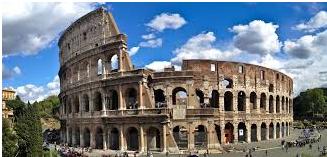Widgetized Section
Go to Admin » Appearance » Widgets » and move Gabfire Widget: Social into that MastheadOverlay zone
Rome Wasn’t Built in a Day
The views expressed are those of the author and do not necessarily reflect the views of ASPA as an organization.
By John Carroll
October 9, 2015
Rome, Athens, Ephesus, Xi’an and Stonehenge.
Milan, Venice, London, Paris and Beijing.
The Brooklyn Bridge, Hoover Dam, the United States Capitol and Wrigley Field.
No, this is not a travelogue. Other than my great fortune as being able to visit to all of these places, what is the common thread? Large scale projects of course. All are places where large-scale projects were intentionally built (and managed) by humans to fulfill a purpose. These projects were envisioned, planned, managed, staffed, funded (in one form or another), built and then maintained.
 To walk among the result of these projects, rather than simply read about or view visual representations of them, provides a different perception and appreciation of the scope of effort expended to complete them (as well as restore and/or maintain). The projects of ancient times continue to astound:
To walk among the result of these projects, rather than simply read about or view visual representations of them, provides a different perception and appreciation of the scope of effort expended to complete them (as well as restore and/or maintain). The projects of ancient times continue to astound:
- The Colosseum, Pantheon and Forum of Rome (OK, the whole city is pretty amazing).
- The stones and columned structures that comprise the Acropolis in Athens.
- The incredibly well preserved Roman port and regional capital of Ephesus in Turkey.
- The thousands of individually crafted warriors in the Terracota Army in Xi’an, each protecting the resting place of the first emperor of China.
- The great rock monoliths of Stonehenge.
We can also look to the Medieval/Renaissance period for additional large-scale projects. Walk around the seemingly endless cathedral of Milan (or Florence, if you prefer) or jostle with the pigeons in St. Mark’s Square or the Doges’ Palace in Venice. Touch the final resting places of royalty (and others) in London’s Westminster Abbey. Cruise around the Cathedral of Notre Dame (and many other sights) along the River Seine in Paris. Peer into the Forbidden Palace or walk along the parapets of the Great Wall in Beijing.
In more modern times, we can consider projects that were not only engineering marvels, but functionally outstanding. The Brooklyn Bridge may be over 130 years old, but to walk across it is breathtaking. The same can be said of the Hoover Dam (especially in July when it was 110 degrees). It is not hard to feel a bit patriotic and proud to stand under the great dome of our nation’s Capitol. In the “friendly confines” of Chicago’s Wrigley Field, one truly feels welcomed to see a baseball game the way fans did a century ago.
I must admit that when I visit such places (or most places), I try to question what went into making it happen. What constitutes a “large-scale project”? Is it size, expense, time, the amount of labor and resources, complexity, the purpose it serves or all the above? We can also probably agree that competent leadership is needed to manage large-scale projects from inception to completion. A couple of examples come to mind. Robert Moses, revered or reviled depending on the source, is credited with leading projects that constituted the 20th century rebuilding of New York’s infrastructure. How he did it might be open to debate, but the projects were done. Leslie Groves is the name most associated with building the massive Pentagon headquarters in Arlington, Virginia. He was also central to managing and leading the Manhattan Project to create the atomic bomb.
We are also exposed to lesser successful examples of leading and managing recent large-scale projects, such as the rollout of the Affordable Care Act, seemingly everything related to the Department of Veterans Affairs and countless others at the state and local level. Shameless plug alert here: I find that ASPA’s partnership with Government Management Daily a terrific source for these (and many other) types of stories. In my daily email, I read about some very good large-scale project success stories and some others that cause me to say, “I’m glad I’m not that guy.”
None of the 90,000 units of American government has a vast cadre of construction employees or the other specialties needed to build large scale projects. Everything we need or build is purchased from the private (or nonprofit) sectors. Private contractors, with public employees somewhere in the management/coordinator mix, carry out all public projects. Public projects, especially large-scale ones, are a collaboration of public and private resources. Public projects should also have skilled leadership and oversight from beginning to end – as we know that these things take time.
There are many ancient projects lost to time, many (many) more to visit not mentioned here and probably many more yet to be discovered. For me, the large projects of places yet to come include those in places like Jerusalem, Giza and Petra. Projects such as the Hagia Sophia, Angkor Wat, Macchu Picchu and the Taj Mahal and so many others not mentioned here, are also on my list. What am I waiting for?
Author: John J. Carroll, Ph.D., is an assistant professor for public administration at Nova Southeastern University, in Fort Lauderdale, Florida. Before joining academia, he served in the public sector for more than 30 years. Email: [email protected].


Follow Us!